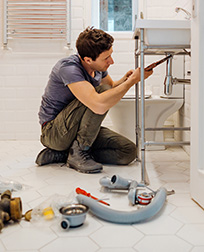Professional Water Heater Installation Alabaster AL You Can Count On
Professional Water Heater Installation Alabaster AL You Can Count On
Blog Article
A Detailed Overview to Reliable Hot Water Heater Setup for Optimal Efficiency
Getting started on the job of setting up a water heater is an endeavor that demands precision and a systematic technique for accomplishing optimal performance. As you continue, the complexities of linking water supply lines and setting up trustworthy electric or gas links await, appealing insights into ensuring efficiency and reliability.
Choosing the Right Hot Water Heater

Next, consider the size and capability of the water heating system. It's important to assess your family's hot water demands, which can differ based upon the number of occupants and their use patterns. A system that's too little may lead to inadequate warm water, while a large model could cause unneeded power intake.
Efficiency rankings also play a critical role in selection. Look for hot water heater with high Energy Factor (EF) ratings, showing remarkable performance and decreased energy use. Tankless versions, though commonly much more expensive ahead of time, offer considerable power cost savings in time due to their on-demand home heating capacities.
Preparing the Setup Location
Before setting up a new water heating unit, thorough preparation of the setup location is essential. It's essential to gauge the space very carefully to accommodate the water heating system's measurements, making certain sufficient clearance around the system for effective procedure and maintenance.
Following, eliminate any particles, dirt, or blockages from the website to create a tidy environment. Inspect the flooring for stability, as the hot water heater will certainly require a strong, level surface to operate effectively. If necessary, mount a drip pan underneath the system to capture prospective leaks or spills, stopping water damages to the surrounding location. In regions vulnerable to seismic task, think about mounting seismic bands to secure the heating unit firmly in area.
In addition, make sure that all essential devices and products are on hand prior to starting the installment. This includes products such as wrenches, screwdrivers, a degree, and any added hardware needed for securing the heater and mounting. A well-prepared installment area sets the structure for an effective water heating unit arrangement, maximizing efficiency and safety.
Connecting Water Supply Lines
When attaching water supply lines to your recently mounted water heater, it is critical to ensure that all links are leak-free and safe and secure to preserve efficient procedure and avoid water damages. Begin by recognizing the warm and chilly water lines. The cool water inlet is commonly marked with a blue label or a "C", while the warm water electrical outlet is noted with a red tag or an "H".
Use versatile water heating unit adapters to facilitate a simpler installation procedure. These ports can absorb vibration and enable slight movement, minimizing the risk of leaks. Before affixing the ports, put a plumbing's tape around the threaded ends of the water heater's inlet and outlet pipes - Plumber Alabaster AL. This tape functions as a sealer, stopping leakages. Carefully connect the flexible tubes to the particular inlet and outlet, making certain that they are tight but not over-tightened, which can harm the threads.
As soon as links are in place, slowly activate the major water supply valve. Examine each link for leaks by aesthetically feeling and examining for dampness. Tighten up connections as needed, and make sure the pressure alleviation valve is appropriately mounted, safeguarding versus extreme pressure build-up.
Establishing Up Electrical or Gas Connections
Effectively establishing up the electrical or gas links for your hot water heater is an essential step to ensure secure and reliable operation. For electrical hot water heater, start by validating that the electrical circuit works with the heating unit's voltage and amperage demands. Make sure the power supply is shut off at the breaker to discover here stop mishaps. Attach the electrical cables to the heater adhering to the maker's circuitry layout. Normally, this includes linking the ground cable to the environment-friendly terminal, and the staying wires to their matching terminals, securing each with wire nuts.
For gas water heating systems, safety and security is critical. Validate that the gas supply is off prior to continuing. Attach the gas line to the hot water heater making use of an adaptable gas connector, guaranteeing it is properly threaded and secured with pipe joint substance or Teflon tape appropriate for gas links. Tighten up the links with a wrench, making sure not to over-tighten (Plumbing Services Alabaster AL).
When try here links are made, evaluate for any possible leaks. For gas lines, apply a soapy water solution to the joints; bubbles suggest a leak. For electric connections, ascertain that all wiring is protected and appropriately protected, preserving conformity with regional electric codes.
Readjusting and checking for Efficiency
With the electric and gas links firmly in place, the following step is assessing the functional effectiveness of your water heating unit. Begin by very carefully turning on the water supply and making certain there are no leaks at any of the shutoffs or joints.
Following, carry out a detailed assessment to ensure the heating aspects or burner are working properly. For electrical heating units, make use of a multimeter to confirm if the elements are drawing the appropriate current. In gas designs, observe click here to read the burner flame; it ought to be consistent and blue, indicating efficient combustion.
Change the settings as necessary to remove inadequacies. Take into consideration carrying out insulation actions, such as including a hot water heater covering, to even more improve efficiency by decreasing warm loss. In addition, examine the anode rod's condition, as a deteriorated pole can minimize performance and cause tank rust.
Conclusion
Reliable water heating system installation is vital for making sure optimum efficiency and power savings. Safely linking water supply lines and very carefully setting up electric or gas links decrease possible concerns.

Correctly setting up the electric or gas connections for your water heating unit is an essential step to make sure secure and reliable operation. For electric water heating systems, begin by verifying that the electrical circuit is compatible with the heating system's voltage and amperage demands. Link the gas line to the water heating unit making use of a flexible gas adapter, guaranteeing it is appropriately threaded and sealed with pipe joint substance or Teflon tape appropriate for gas connections.
Report this page